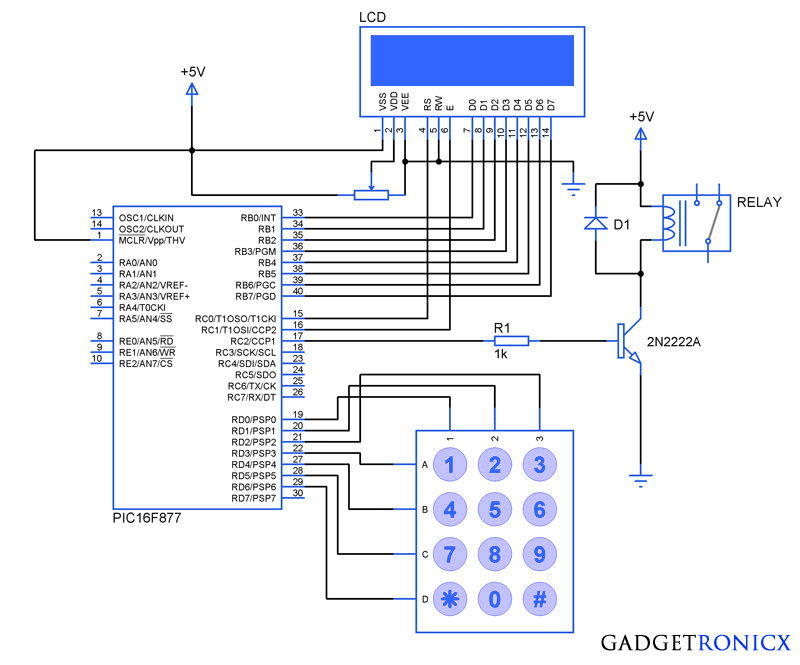 |
| Electronic Combination lock PIC Mircocontroller |
Electronic code locking system is extremely useful in protecting our precious possessions and can be installed anywhere with bit of engineering in it. We are widely familiar with the Password based e-locks and might have installed in our house. But we are going for Electronic locks made by any company when you can make one by your own.
This project demonstrates you how to make a PIC microcontroller based simple digital lock and also explains the programming behind it.
WHAT YOU NEED:
- PIC 16F877 Microcontroller
- 4×3 Keypad – Key Input
- 16×2 LCD – Status Indicator
- 5V Relay – Activator
Additionally you need a POT which is used to adjust the contrast of the LCD, A transistor to drive the relay since the current obtained from a Pin of Microcontroller is very less. A diode to prevent the reverse flow of current which might damage the controller.
DESIGN OF ELECTRONIC CODE LOCKING SYSTEM:
The design of the above Embedded Project is pretty straight forward, you need to interface a LCD to PORT B and Keypad to the PORT D of the Controller. If you are not familiar with it then i suggest you to go through this Interfacing LCD and Keypad with PIC Microcontroller. Now lets see how the system is designed to work as a Locker.
- “*” Key – This key is meant to initialize the system, when the system is turned ON the Controller will scan only this key and pressing this key will enable you to enter the password for your locker.
- “#” Key – When you are done with your locker , you should press this key which will turn off the system and turning off the relay as well.
The remaining keys are meant to feed the character values to the Microcontroller and in turn the Microcontroller will analyze the characters. Based on the Pre defined password in the Controller it will compare the input with it. Thereby it will recognize the correct or incorrect password input.
CODE:
#include<16F877.h>
#include<stdio.h>
#bit led=0x05.0
#bit TRIS_led=0x85.0
#byte lcd=0x06
#byte TRIS_lcd=0x86
#bit rs=0x07.0
#bit TRIS_rs=0x87.0
#bit en=0x07.1
#bit TRIS_en=0x87.1
#bit relay=0x07.2
#bit TRIS_relay=0x87.2
#bit C1=0x08.0
#bit C2=0x08.1
#bit C3=0x08.2
#bit R1=0x08.3
#bit R2=0x08.4
#bit R3=0x08.5
#bit R4=0x08.6
#bit TRIS_C1=0x88.0
#bit TRIS_C2=0x88.1
#bit TRIS_C3=0x88.2
#bit TRIS_R1=0x88.3
#bit TRIS_R2=0x88.4
#bit TRIS_R3=0x88.5
#bit TRIS_R4=0x88.6
void display(unsigned char a,int b); //LCD subroutine
char keypad(); //Keypad Subroutine
void check(); //Password check routine
char password[5]={"7196"}; //Predefined password
char pswd[5];
unsigned char open_msg[15]="Enter Password";
unsigned char welcome_msg[8]="Welcome";
unsigned char close_msg[15]="Wrong Password";
char c;
int flag,i,count,j;
void main()
{
TRIS_lcd=TRIS_en=TRIS_rs=TRIS_led=TRIS_relay=0; //Directions set
TRIS_R1=TRIS_R2=TRIS_R3=TRIS_R4=count=0;
TRIS_C1=TRIS_C2=TRIS_C3=1;
while(TRUE)
{
c=keypad();
{
if(c=='*') //Initialize condition
{
flag=1; //Flag set to scan other keys
count=0;
display(0x01,0);
display(0x38,0);
display(0x0f,0);
display(0x80,0);
for(i=0;i<=13;i++)
{
display(open_msg[i],1);
}
display(0xc0,0);
}
else if(c=='#') //Turning off condition
{
count=0;
relay=0;
display(0x01,0);
display(0x0c,0);
}
else
{
display('*',1);
pswd[count]=c; //Storing input in new arrays
count=count+1;
check();
}
}
}
}
void display(unsigned char a,int b)
{
lcd=a;
rs=b;
en=1;
delay_ms(10);
en=0;
delay_ms(10);
}
char keypad()
{
if(flag==0) //Waiting for Initialization
{
while(TRUE)
{
R4=1;
R1=R2=R3=0;
if(C1==1)
{
while(C1==1);
count=0;
return '*';
}
if(C3==1)
{
while(C3==1);
count=0;
return '#';
}
}
}
else if(flag==1)
{
while(TRUE) //Keypad scan
{
R1=1;
R2=R3=R4=0;
if(C1==1)
{
while(C1==1);
return '1';
}
if(C2==1)
{
while(C2==1);
return '2';
}
if(C3==1)
{
while(C3==1);
return '3';
}
R2=1;
R1=R3=R4=0;
if(C1==1)
{
while(C1==1);
return '4';
}
if(C2==1)
{
while(C2==1);
return '5';
}
if(C3==1)
{
while(C3==1);
return '6';
}
R3=1;
R1=R2=R4=0;
if(C1==1)
{
while(C1==1);
return '7';
}
if(C2==1)
{
while(C2==1);
return '8';
}
if(C3==1)
{
while(C3==1);
return '9';
}
R4=1;
R1=R2=R3=0;
if(C1==1)
{
while(C1==1);
return '*';
}
if(C2==1)
{
while(C2==1);
return '0';
}
if(C3==1)
{
while(C3==1);
return '#';
}
}
}
}
void check()
{
if(count>3) //Input exceeds count 3 will execute comparison
{
flag=count=0;
j=strcmp(pswd,password); //Comparison of input and Predefined pswd
if(j==0)
{
relay=1; //Turning relay on
display(0x01,0);
display(0x80,0);
for(i=0;i<=6;i++)
{display(welcome_msg[i],1);}
}
else
{
relay=0;
display(0x01,0);
display(0x80,0);
for(i=0;i<=13;i++)
{display(close_msg[i],1);}
}
}
}
NOTE:
- You can add additional security by adding trial above code.
- It can be done by making the trial value to increase for every wrong password input and checking the condition whether it exceeds the desired trial value.
- Once it exceeds the desired trial value disable the keypad scan and display message “No more trials” in the LCD.
- You can also add speaker to sound a alarm once the trial exceeds to alert the people nearby.

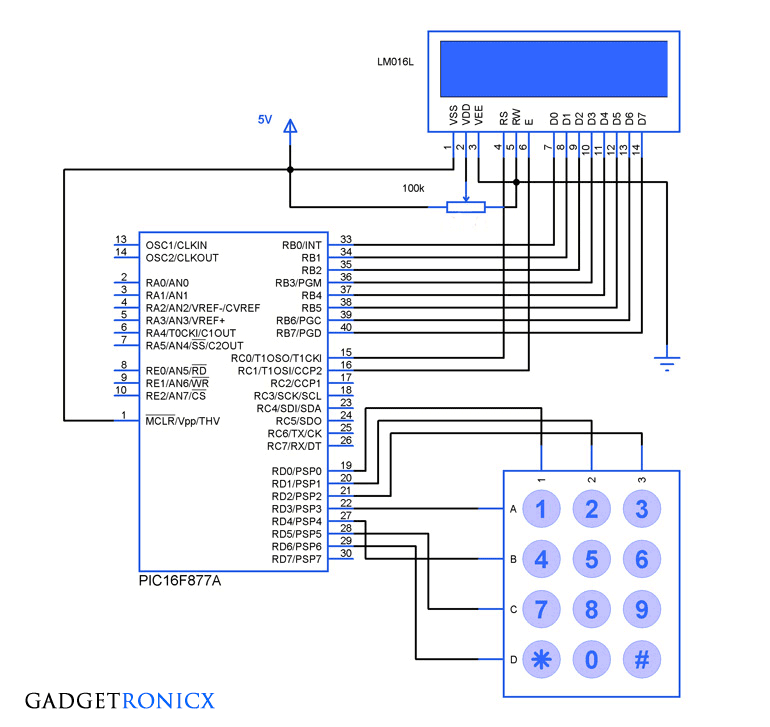

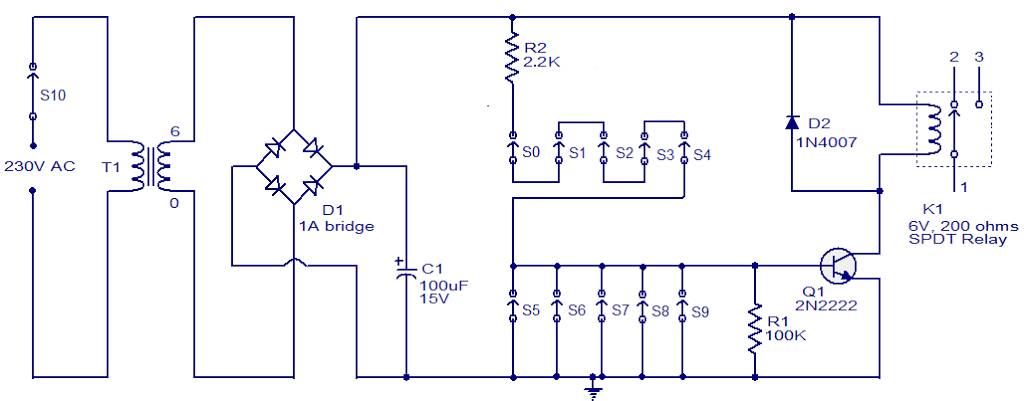
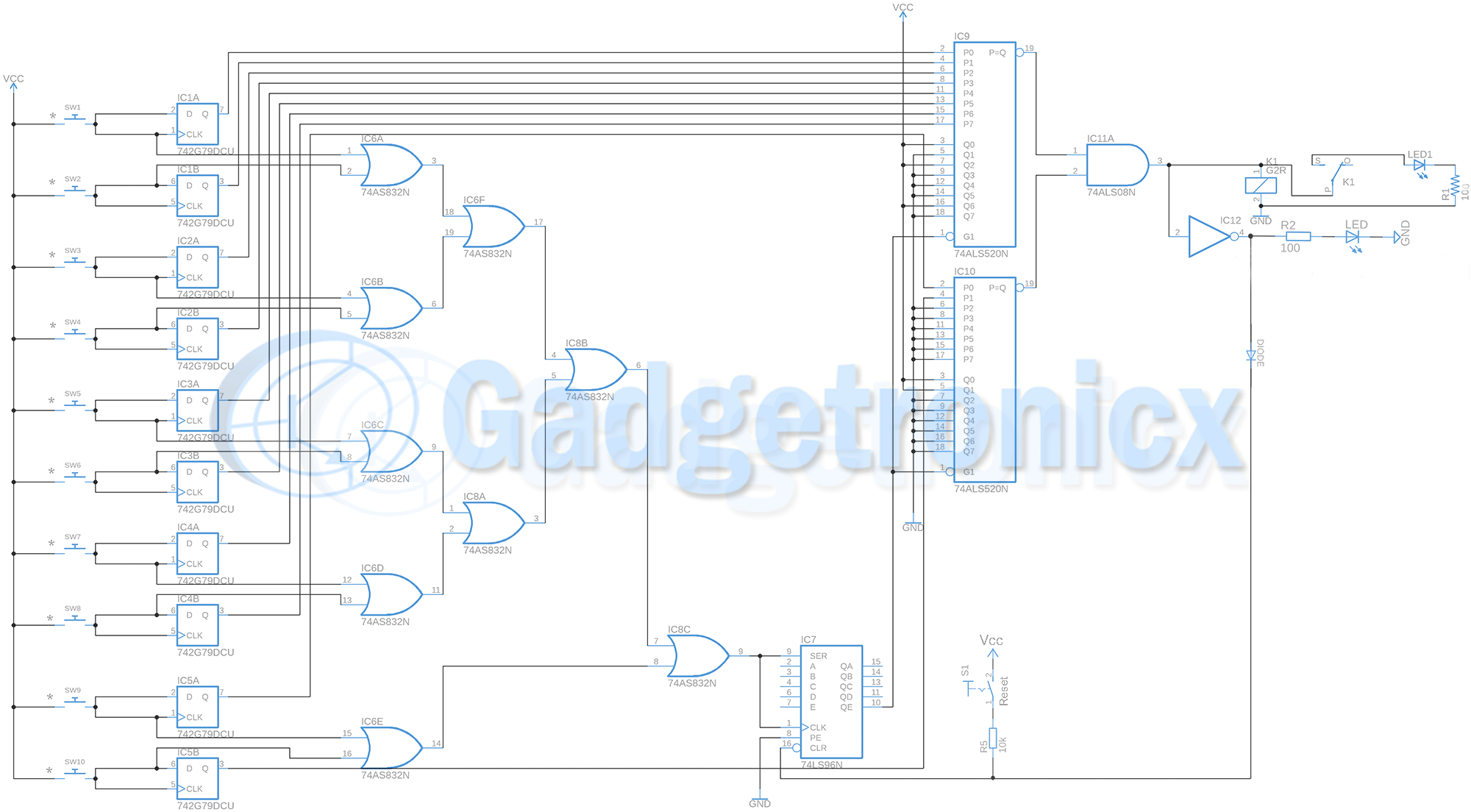
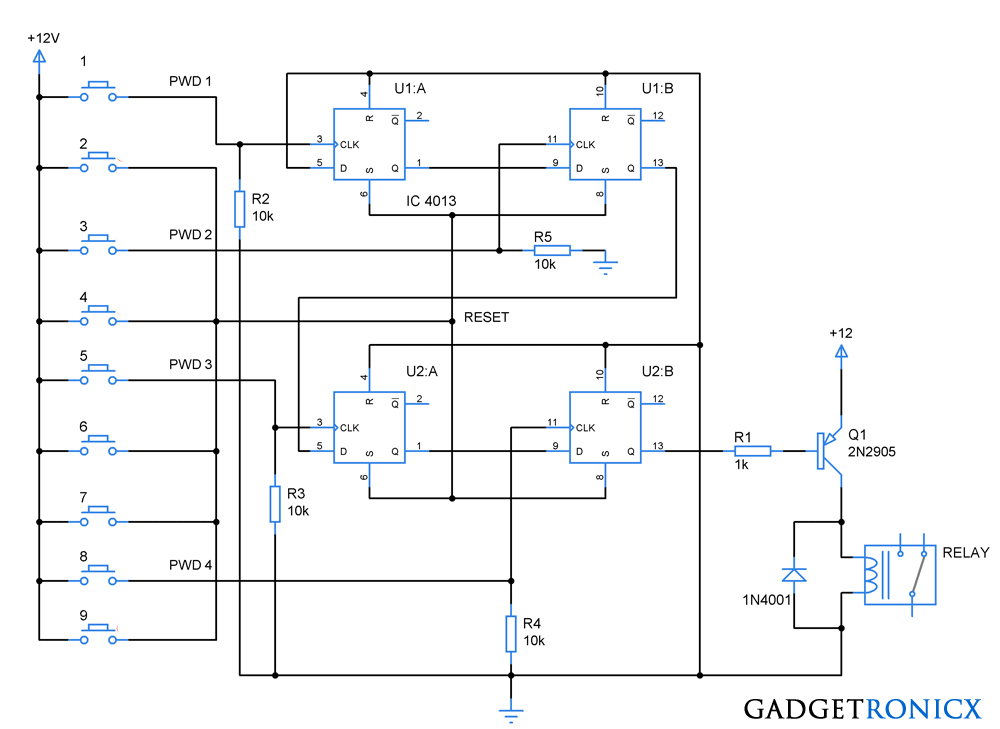
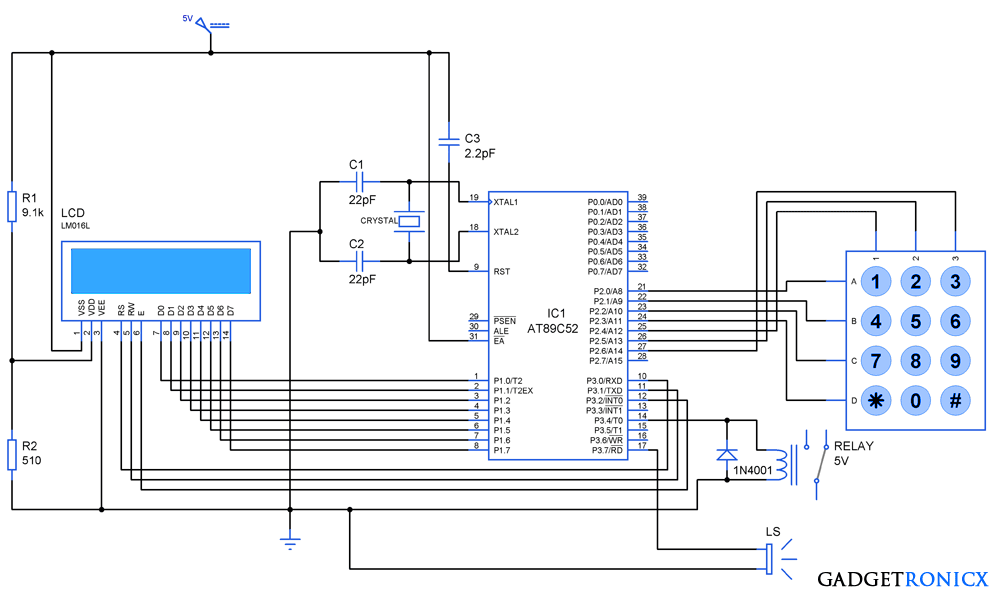
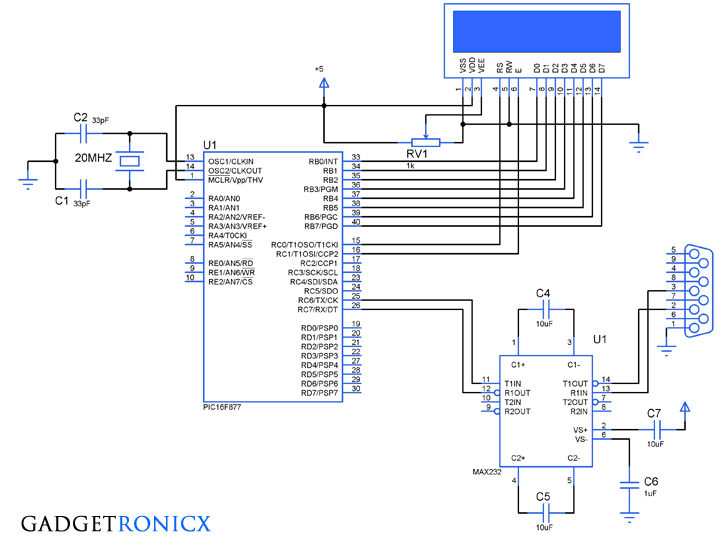
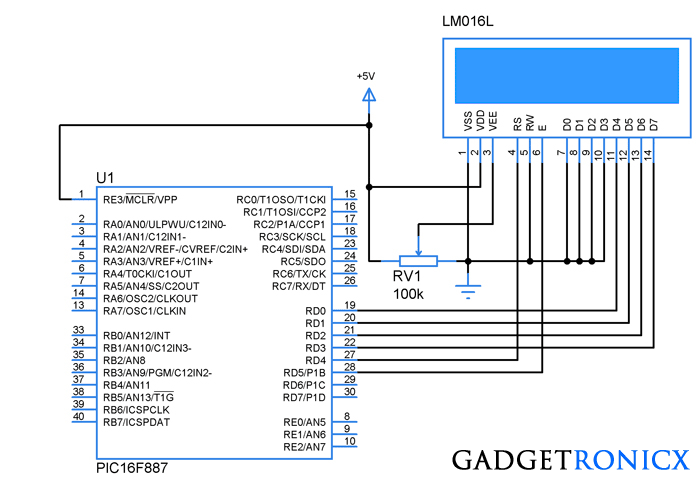

Hi Frank could you please send me the hex file for this project. I get the undefined identifier for delay_ms error when I try to compile using the CCS compiler. Thanks in advance.
Alex,
Try adding this line
to the code , this header defines the crystal used for your project which in turn supply the delay. You can alter the value in this line as per your crystal usage.
please provide the hex file
Respected Sir, Can you please send me the hex file ?
Hello , i want to know if i can add an alarm system if the is not right
Khawla,
Of course you can add and set it off once wrong password is entered or when trail is over.
Hey frank, can you kindly send me the hex file its quite urgent. Thank you.
mohammadali_95@hotmail.com
hi frank,can i have the header of this code?because i cannot compile. thank for your help.
Eka,
Which compiler you are using?
hi sir thank you for the good work, can you send me the hex file of this? i need it for my project. at this mail,(danieladusei573@gmail.com thank you hope to hear from you soon
hi..can i get the hex file. it will help me a lot for my school project…thanks
hello Frank Donald thanks very much for sharing this.i was thinking of designing something exactly like this for my final year project but through LAN. i really appreciate the design. I copied and compiled the code succesfully without any error and i’ve build the circuit and simulated with isis proteus and its working perfectly.
But what i wish to ask is what modifications can i make to the system to include more features on security and please i will be all grateful if you could explain to me sections of the code and how i can connect a mechanism to the circuit to actually serve as a door(i’ve used a simple lamp and it works)…hope to hear from you soon!!!
THANKS IN ADVANCE!!!
Nkamwa,
Can you be more specific with your question? “More features on security” what sort of features you are expecting to add in your project, brief a bit about it so that i can get good understanding. Relay or Reed switches are perfect devices for activating doors and stuffs, you will find plenty of attachable locking modules in the internet, but make sure you read and understand the specs of it properly.
Sir, Please send me the hex file. My University project show date is 10/12/2015 . It is urgent !!!!